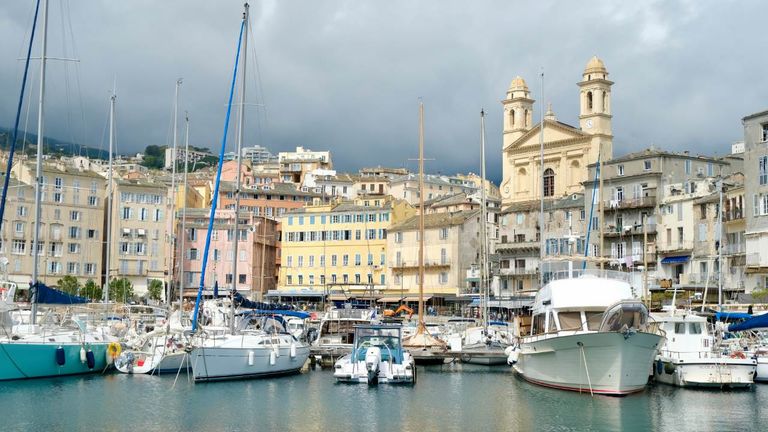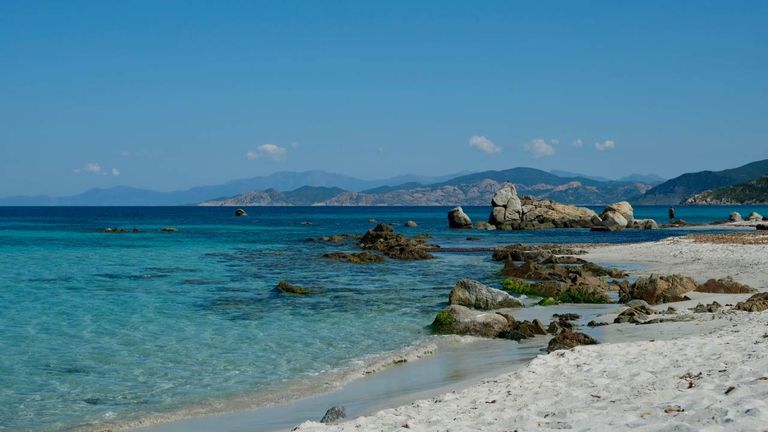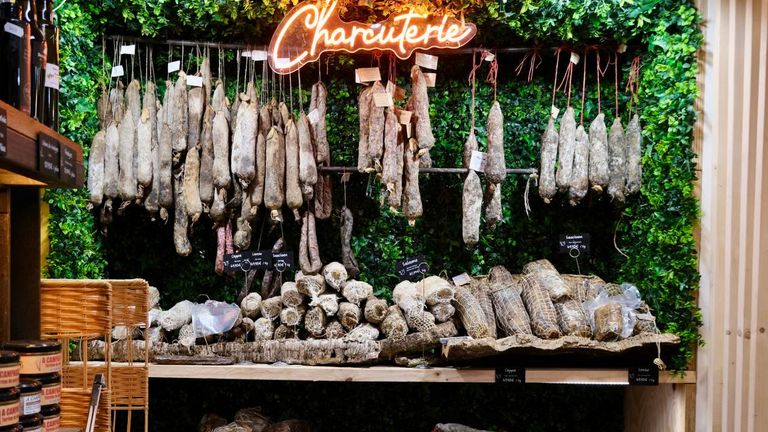The island of Corsica (or “La Corse” in French) remains under the radar for most visitors to France. However, with clear turquoise waters, breathtaking rugged landscapes and charming historic towns, this locale — the birthplace of Napoleon — offers a unique holiday destination.
Corsica has immense appeal for active travelers, beach lovers, culture seekers and foodies alike. Here’s what can tempt your clients to France’s Ile de Beauty (“the isle of beauty”).
What to Know Before You Go
The fourth largest island in the Mediterranean, Corsica sits just above Sardinia, some 100 miles southeast of mainland France and 50 miles west of Italy. Controlled by the Genovese for centuries, the island fell under French rule in 1769, after a short bout as an independent republic.
Although Corsica’s official language is French, many locals also speak Corsu (or also known as Corsican), a dialect with Italian roots. As such, many towns also have a French and a Corsican name, both of which are usually listed on road signs and transport schedules — though not always, so tell clients to keep this in mind.
The island is divided into two counties: Haute-Corse (Northern Corsica) and Corse-du-Sud (Southern Corsica), where the island’s main cities — Bastia and Ajaccio, respectively — are located. While it’s possible to visit both sides of the island on one trip, visitors usually focus on one, depending on their interests.
 Clients will find lots of lively restaurants in Bastia's Old Port.
Clients will find lots of lively restaurants in Bastia's Old Port.
Credit: 2025 Lily HeiseWhat to Do in Corsica
Take in the Island’s History and Culture
Ajaccio is a must for lovers of history and art. The birthplace of Napoleon, there are various sites linked to the emperor, from statues to his family’s home. The city also houses the island’s leading art museum, Palais Fesch, which contains the art collection of Napoleon's uncle, Cardinal Fesch, and a whole wing of dedicated to the Bonapartes.
Bastia's historic Terra Nova district allows clients to travel back in time and features Museu di Bastia, which dates to the 14th century. Visitors can also view the city’s Genovese fortifications and meander the colorful Old Port, lined with lively restaurants.
 The central Corsica town of Corte is home a historic citadel.
The central Corsica town of Corte is home a historic citadel.
Credit: 2025 Lily HeiseVisit Corte to delve deeper into the island’s history and traditions. Briefly the capital under its short-lived republic, it’s home to the wonderful Museu di a Corsica, an awe-inspiring citadel on a rocky spur, and soaring mountain vistas. Archaeology buffs won’t want to miss the Roman ruins of Aleria and the prehistoric site of Filitosa, which contains 3,500-year-old stone megaliths.
Visit Picturesque Seaside Towns and Hilltop Villages
Corsica’s north coast has some of the island’s loveliest coastal towns, including Calvi, L’Ile-Rousse and Saint-Florent, all of which have the backdrop of ancient fortresses and sweeping bays. Clients could spend a few days exploring these towns, as well as neighboring hilltop villages such as Pigna, Speloncato and Sant’Antonino. In the south, Bonifacio is perched atop white limestone cliffs, and chic Porto-Vecchio is perfect for browsing elegant boutiques and soaking up posh ambience.
Admire the Island’s Coastline by Boat
Corsica’s jagged coastlines and outlying islands are best viewed from the water. A range of top boat trips depart from Ajaccio and other seaside destinations and visit the Sanguinaires Islands, Scandola Nature Reserve and the pink inlets of Piana and Bonifacio.
Partake in Active Pursuits
Corsica’s a mecca for outdoor enthusiasts, and the most popular activity is hiking. Many come solely to do the GR20, a challenging 112-mile trail that travels through spectacular scenery and traditionally takes 16 days. More casual hikers can do stretches of it or take other shorter trails, such as the Sentier des Douaniers (Customs Officers’ Path), a 14-mile path that crosses the gorgeous Cap Corse peninsula north of Bastia.
Clients can also enjoy Corsica’s sublime scenery by bike. Only experienced cyclists should take on the more challenging trails; however, electric bikes are available for rent in tourism hubs and are more suitable for leisurely rides.
Taking in some watersports — such as kayaking, standup paddleboarding, Jet Skiing and windsurfing — is a wonderful way to view the picturesque coastline, and visitors will find rental agencies in most seaside towns. Thrill-seekers can go paragliding or canyoning through the interior’s mountainous valleys.
 The blue waters of L'Ile Rousse beach make it a favorite stopping point.
The blue waters of L'Ile Rousse beach make it a favorite stopping point.
Credit: 2025 Lily HeiseRelax on Beautiful Beaches
Many visitors come to Corsica for a beach holiday — and its white and golden sands and aquamarine waters do not disappoint. Although clients will find lovely beaches all around the island, the east coast around Porto-Vecchio [h] is known for having the most beautiful sands, such as Palombaggia and Tamaricciu.
Near Bonifacio, the white sands and crystal-clear waters of Rondinara Beach evoke the Caribbean, and the northern beach of Ostriconi, near L’Ile-Rousse, also has fine sand, turquoise waters and a wilder setting.
 Recommend clients sample Corsican charcuterie.
Recommend clients sample Corsican charcuterie.
Credit: 2025 Lily HeiseSample Corsica’s Culinary Traditions
Corsicans are very proud of their gastronomy, so you’ll see plenty of specialty food shops and “menus corses” offered at restaurants. Among popular specialties are artisan sausages, goat cheeses, lamb or wild boar stew, and chestnut products. Since Corsica is an island, clients will find good seafood, but the local blue lobster, oysters and fresh catches of the day are pricey. For an excellent primer on Corsican cuisine, join a No Diet Club food tour in Ajaccio which includes copious tastings at exceptional specialty food shops.
Where to Stay
Only a 15-minute drive from the Ajaccio airport, Sofitel Golfe d'Ajaccio Thalassa Sea & Spa is perched on the edge of a peninsula with sweeping views of the city and coastline. The 98-room five-star hotel has a gourmet Corsican restaurant, a thalassotherapy seawater spa, an infinity pool, a private beach and a wide range of activities — from helicopter tours to sunset boat cruises.
For a city stay in Bastia, Hotel Les Gouverneurs is a four-star boutique hotel in the historic Terra Nova district with lovely views over the Old Port. Savor the buzz of stylish Calvi at Hotel Maria Die, a four-star boutique with a contemporary feel.
Beach lovers can wake up and dip their feet into the turquoise waters of Porto-Vecchio at La Plage Casadelmar, a five-star property nestled within a pine grove with 20 rooms and a two Michelin-star restaurant. For more laid-back beach vibes, send clients to Hotel Liberata & Spa, a refurbished art nouveau manor house in L’Ile-Rousse right across from the beach.
How to Get There and When to Go
Clients can reach Corsica by plane or ferry. Corsican airports don’t receive transatlantic flights, so North American visitors usually take a 1.5-hour flight from Paris or a 50-minute flight from Nice, operated by Air France, Air Corsica or EasyJet. The island’s two main airports are in Ajaccio and Bastia, but in high season, there are frequent flights to the airports of Calvi (northwest) and Figari (far south).
Taking the ferry is a good option if your clients will also be visiting the South of France or Northern Italy. There are several companies, including Corsica Ferries and La Meridionale, that connect Marseilles, Toulon, Nice and the Italian port of Piombino to Bastia, Ajaccio and Porto-Vecchio year-round, and some ferries also dock at L’Ile-Rousse in high season. The journey takes four to six hours during the day and 12 hours at night.
Many tourism facilities close from mid-October to mid-April, so it’s best to avoid this time frame. Balmy spring and autumn are ideal for hiking and sightseeing. The hot summer is best for the beach, but be sure to book travel and accommodation well in advance, as this is when French holiday-goers descend on the island.
How to Get Around
Some visitors may prefer to stay in one place and take day trips instead of staying overnight in different towns. A scenic train travels between Ajaccio, Bastia, Corte, L’Ile-Rousse and Calvi, while various bus companies serve Bonifacio and Porto-Vecchio.
If clients would like to visit Corsica’s loveliest villages, they’ll need a car — or do a lot of hiking or biking. There are plenty of curvy mountainous roads, so driving here isn’t for the fainthearted. It’s best to rent a car that’s powerful enough for the hills, but not too big for the narrow roads. Clients should plan to go clockwise around the island so they’ll be on the inside of the road rather than cliffside.